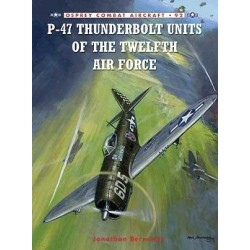
P-47 THUNDERBOLT UNITS OF THE TWELFTH AIR FORCE.
- Each Combat Aircraft book concentrates on one of the greatest aircraft in aviation history, the technology behind it and the men who flew it. Examining the design, development and deployment of the aircraft throughout history, from World War II and Korea through to current actions in the Gulf and Afghanistan, each book features up to 30 aircraft profiles, pages of full-colour nose art and black and white photographs throughout. The Combat Aircraft series provides a valuable resource for military model makers, remote control model makers and aviation history enthusiasts.
The P-47 Thunderbolt, originally designed as a high-altitude interceptor, became the principal US fighterbomber of World War II. First adapted to the ground attack role by units of the Twelfth Air Force in early 1944, the strength and durability of the P-47 airframe, along with its massive size, earned it the nickname Juggernaut, which was quickly shortened to Jug throughout the MTO and ETO. By October 1943, with the creation of the Fifteenth Air Force, nearly half of the Twelfths fighter groups would be retasked with strategic escort missions, leaving six groups to perform close air support and interdiction missions throughout the entire Mediterranean theatre. The groups inflicted incredible damage on the enemys transport routes in particular, using rockets, bombs, napalm and machine-gun rounds to down bridges, blow up tunnels and strafe trains. Myriad first-hand accounts and period photography reveal the spectacular success enjoyed by the Thunderbolt in the MTO in the final year of the war.
Contents:
- Early Operations (transition from Ninth to Twelfth Air Force and early development of ground support in the North African Desert)
- Easing in the P-47 (the P-47 was much more conducive to the ground attack mission than inline-powered fighters, but adapting pilots to the new, more powerful but much heavier fighter took some adjustment)
- Anzio (covering the invasion force and interdiction behind the stalemated beachhead)
- The Drive to Rome (air cover for Fifth Army through Monte Cassino and the advance to the Gothic Line)
Dragoon (shifting units to cover Operation Dragoon (invasion of southern France) while maintaining essential sorties over the front in Italy)
- Northern Italy (27th, 57th and 350th FGs in action in the autumn winter 1944-45)
- Colmar Pocket and the Rhineland (79th, 86th and 324th FGs in action in Southern France in the autumn
winter of 1944-45)
- Final Victory (the drive to Germany)
- Appendices (-Twelfth Air Force units and airfield locations -Colour plate commentary)

